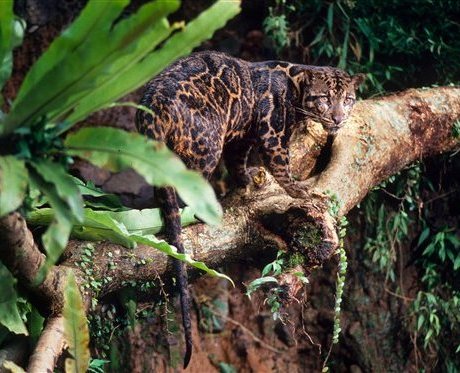
March 15, 2007

Talk about exciting! The World Wildlife Fund and the World Wide Fund for Nature (WWF) have annouced the discovery of the new animal pictured above, a clouded leopard found by a WWF member inside the Borneo rainforest, East of Malaysia. The clouded leopard of Borneo, discovered to be an entirely new species, is the latest in a growing list of animals and plants unique to the Southeast Asian country’s rainforest and underscores the need to preserve the area, conservationists said Thursday, March 15, 2007. (AP Photo/WWF, Alain Compost, HO)
For fifty years the Clouded Leopard was regarded as a monotypic genus with four subspecies:
* Neofelis nebulosa brachyurus: Taiwan (presumed extinct in the wild)
* Neofelis nebulosa diardi: Borneo, Sumatra, (Java – absent since Neolithic times)
* Neofelis nebulosa macrosceloides: Nepal to Myanmar (Burma)
* Neofelis nebulosa nebulosa: Southern China to eastern Myanmar
New molecular genetic analyses (mtDNA, nuclear DNA sequences, microsatellite variation, and cytogenetic differences) revealed the strong case for reclassification and the defining of two distinct species of clouded leopard – Neofelis nebulosa (mainland Asia) and Neofelis diardi (Indonesian archipelago).
The results of the genetic study are supported by separate research on geographical variation in the clouded leopard, based mainly on fur patterns and coloration of skins held in museums and collections. The Borneo clouded leopard is darker than the mainland species and has many distinct spots within its small cloud markings. It also has a grayer fur, and a double dorsal stripe. Clouded leopards from the mainland have fewer and fainter markings within large clouds on their skin. They are also lighter in color.
“It’s incredible that no one has ever noticed these differences.” said Andrew Kitchener from the Department of Natural Sciences, National Museums, Scotland.
A total of 5,000 to 11,000 Bornean clouded leopards are estimated to live in the jungles of Borneo. The total number in Sumatra could be in the range of 3,000 to 7,000 individuals. The cats’ biggest threat is destruction of their habitat.WWF Study release
See the full press release here: New Species Declared: Clouded Leopard On Borneo And Sumatra.
About Loren Coleman
Loren Coleman is one of the world’s leading cryptozoologists, some say “the” leading living cryptozoologist. Certainly, he is acknowledged as the current living American researcher and writer who has most popularized cryptozoology in the late 20th and early 21st centuries.
Starting his fieldwork and investigations in 1960, after traveling and trekking extensively in pursuit of cryptozoological mysteries, Coleman began writing to share his experiences in 1969. An honorary member of Ivan T. Sanderson’s Society for the Investigation of the Unexplained in the 1970s, Coleman has been bestowed with similar honorary memberships of the North Idaho College Cryptozoology Club in 1983, and in subsequent years, that of the British Columbia Scientific Cryptozoology Club, CryptoSafari International, and other international organizations. He was also a Life Member and Benefactor of the International Society of Cryptozoology (now-defunct).
Loren Coleman’s daily blog, as a member of the Cryptomundo Team, served as an ongoing avenue of communication for the ever-growing body of cryptozoo news from 2005 through 2013. He returned as an infrequent contributor beginning Halloween week of 2015.
Coleman is the founder in 2003, and current director of the International Cryptozoology Museum in Portland, Maine.
Filed under Breaking News, CryptoZoo News, Cryptozoology, Mystery Cats, New Species